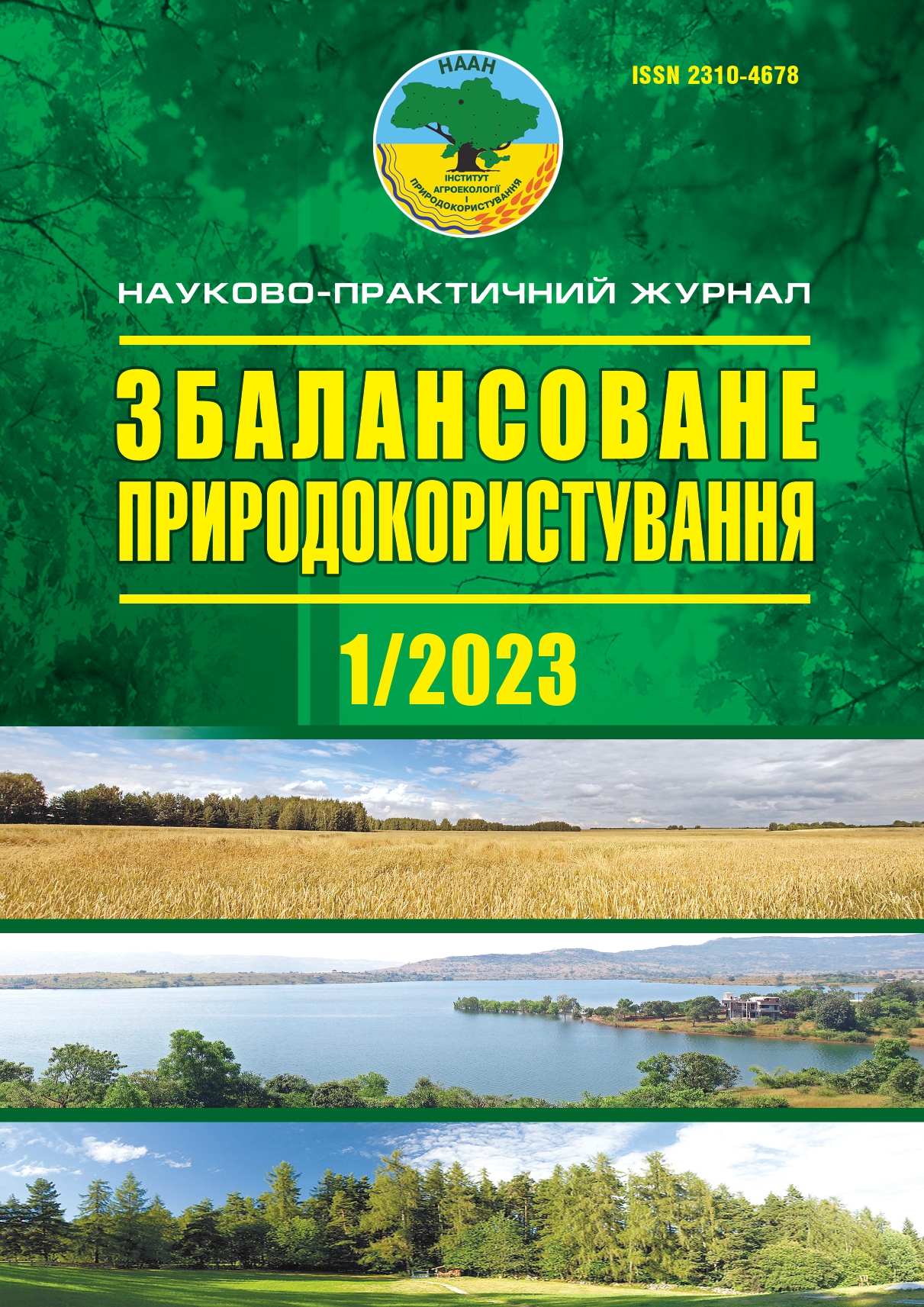Influence of soil herbicides on biometric indicators and yield of sunflower
DOI:
https://doi.org/10.33730/2310-4678.1.2023.278544Keywords:
oil crops, quality of agricultural products, pesticides, productivity, chloracenilides, triazinesAbstract
The article has presented the results of field experiments and laboratory studies of the effectiveness of the use of soil herbicides of various chemical classes in sunflower agrophytocenosis. The effectiveness of the influence of the specified technological aspects on the processes of growth and development, as well as on the formation of quantitative and qualitative indicators of the sunflower harvest, has been established. The research results have confirmed more optimal conditions for the formation of vegetation mass, assimilation apparatus and the root system of sunflower against the background of the application of pre-emergence herbicides. For example, the height of the plants was greater by 2.9–4.5 cm, the length of the root system exceeded the benchmark by 6.1–10.0 cm, the area of the leaf surface — by 1.4–2.8 dm2. When determining such a fundamentally economic and valuable indicator, as seed roughness, а clear regularity of the effect of the use of soil herbicides on this indicator has not been found. The study of the influence of Harness, Dual Gold and Gezagard on the quality indicators of sunflower seeds has showed that the use of herbicides had had a positive effect on the process of oil accumulation. In addition to quality indicators, sunflower yield has been also determined. The yield of the sunflower hybrid Sonachny was 2.64 t/ha when using the herbicide Gezagard, while the yield in the control was 2.13 t/ha. Under the action of Harness and Dual Gold herbicides, the yield was at the level of 2.46–2.47 t/ha, which is 15.5% higher than the control.
References
Bozic, D., Pavlovic, D., Bregola V., Di Loreto, A. et al. (2015). Gene Flow from Herbicide-Resistant Sunflower Hybrids to Weedy Sunflower. Journal of Plant Diseases and Protection, 122 (4), 183–188 [in English].
Chirukuri, R., Atmakuru, R. (2015). Sorption characteristics and persistence of herbicide bispyribac sodium in different global soils. Chemosphere, 138, 932–939 [in English].
Dash, S., Mohanty, N. (2001). Evaluation of assays for the analysis of thermo-tolerance and recovery potentials of seedlings of wheat (Triticum aestivum L.) cultivars. Journal of Plant Physiology, 158 (9), 1153–1165. DOI: https://doi.org/10.1078/0176-1617-00243 [in English].
Hamid, R. M., Abolfazl, T. (2013). Efect of water stress on quantitative and qualitative characteristics of yield in sunfower (Helianthus annuus L.). Journal of Novel Applied Sciences, 2, 299–302 [in English].
Hussain, M., Farooq, S., Hasan, W., Ul-Allah, S., Tanveer, M., Farooq, M., Nawaz, A. (2018). Drought stress in sunfower: Physiological efects and its management through breeding and agronomic alternatives. Agric. Water Manag, 201, 152–166. DOI: https://doi.org/10.1016/j.agwat.2018.01.028 [in English].
Iqbal, H., Yaning, C., Waqas, M., Shareef, M., Raza, S.T. (2018). Diferential response of quinoa genotypes to drought and foliage-applied H2O2 in relation to oxidative damage, osmotic adjustment and antioxidant capacity. Ecotoxicology and Environmental Safety, 164, 344–354 [in English].
Joshan, Y., Sani, B., Jabbari, H., Mozafari, H., Moaveni, P. (2019). Efect of drought stress on oil content and fatty acids composition of some safower genotypes. Plant, Soil and Environment, 65, 563–567. DOI: https://doi.org/10.17221/591/2019-PSE [in English].
Kaczyński, P., Łozowicka, B., Hrynko, I., Wołejko, E. (2016). Behaviour of mesotrione in maize and soil system and its influence on soil dehydrogenase activity. Science of the Total Environment, 566, 144–156 [in English].
Kaya, Y., Evci, G., Pekcan, V., Yilmaz, I. (2013). Clearfield Technology in Sunflower and Developing Herbicide Resistance Sunflower Hybrids. Soil-Water Journal, 2 (2), 1713–1720 [in English].
Mostafa, H., El-Ansary, M., Awad, M., Husein, N. (2021). Water stress management for sunfower under heavy soil conditions cooling efectiveness. Agricultural Engineering International: CIGR Journal, 23 (2), 76–84 [in English].
Norris, R.F. (1996). Water use efficiency as a method for predicting water use. Weed Technology, 10, 153–155 [in English].
Pfenning, M., Palfay, G., Guillet, T. (2008). The CLEARFIELD® technology — A new broadspectrum post-emergence weed control system for European sunflower growers. Journal of Plant Diseases and Protection — New Series, 21, 649–654 [in English].
Vseukrainska ahrarna rada [All-Ukrainian Agrarian Council]. URL: https://uacouncil.org/uk [in Ukrainian].
Zabolotnyi, O.I., Zabolotna, A.V. (2019). Zalezhnist formuvannia vysoty ta lystkovoi poverkhni roslyn kukurudzy vid vnesennia herbitsydu “Batu, v.h.”. [Dependence of the formation of the height and leaf surface of corn plants on the application of the herbicide "Batu, v.g."]. Tavriiskyi naukovyi visnyk. Zemlerobstvo, roslynnytstvo, ovochivnytstvo ta bashtannytstvo — Taurian Scientific Herald. Agriculture, plant growing, vegetable growing and melon growing, 106, 64–70 [in Ukrainian].
Mazur, S.O., Tsvihun, V.O., Sherstoboieva, O.V. (2021). Biolohichna aktyvnist gruntu v ahrotsenozi soniashnyku za vnesennia gruntovykh pestytsydiv [Biological activity of the soil in the sunflower agrocenosis due to the application of soil pesticides]. «VINSMARTECO»: materialy II Mizhnarodnoi naukovo-praktychnoi konferentsii (Vinnytsia, 20–21 travnia 2021 r.). — Materials of the II International Scientific and Practical Conference (p. 59–61). Vinnytsia: KZVO «Vinnytska akademiia bezperervnoi osvity» [in Ukrainian].
Parshykovoi, T.V. (Ed.), Voitsekhivska, O.V., Kapustian, A.V., Kosyk, O.I. et al. (2010). Fiziolohiia roslyn: praktykum [Physiology of plants: workshop]. Lutsk: Teren [in Ukrainian].
Downloads
Published
Issue
Section
License
- The authors reserve the right to authorship their work and pass the journal the right to publish this work under a Creative Commons Attribution License license, which allows other persons to freely distribute the published work with the obligatory The authors of the original work and the first publication of this magazine.
- The authors have the right to make independent additional agreements on the nonexclusive dissemination of the work in the form in which it was published by this magazine (for example, to post work in the company's electronic storage or to publish as a monograph) , subject to the first publication of the link to this journal.
- Journal policy allows and encourages the placement of authors on the Internet (for example, in the repositories of institutions or on personal websites) manuscript work as to the presentation of this manuscript to the editorial board and during its editorial processing, as it contributes to The productive scientific discussion and positively affects the efficiency and dynamics of citation published work (see The Effect of Open Access).


